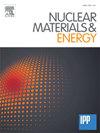Improved erosion estimates for the STEP divertor
IF 2.7
2区 物理与天体物理
Q1 NUCLEAR SCIENCE & TECHNOLOGY
引用次数: 0
Abstract
Net tungsten erosion and deposition profiles are simulated for the outer and inner lower divertor of STEP, a spherical prototype fusion reactor targeting ∼ 2040. In this contribution, previous modelling work [1] has been extended by studying the influence of various input parameters. Main aim is to analyse the influence of several modelling improvements on the erosion/deposition characteristics at the divertor targets. This comprises the consideration of an electron density decay according to the Boltzmann relation within the sheath region as well as a certain tungsten influx to the divertor originating from main wall erosion. Also, for the inner divertor improved background plasma parameters are applied taking into account a gradient along the flux surfaces compared to formerly constant electron temperature and density and ion temperature along the flux surfaces. ERO simulations have been performed for one selected plasma case with Ar seeding, both for the outer (with peak target Te ∼ 25 eV) and inner lower divertor (with peak target Te ∼ 3 eV).
The simulated tungsten erosion and redeposition profiles do not significantly change for the cases studied if the Boltzmann-related decay of electron density within the sheath is considered. The assumption of tungsten within the background plasma can notably alter the overall erosion/redeposition behaviour at a background tungsten concentration of 1/10 with respect to the Ar divertor concentration. The inner divertor target plate shows net deposition everywhere, while at the outer one the net erosion zone becomes smaller and the maximum net erosion peak reduces by a factor of two. Lastly, the improved background plasma for the inner divertor has moderate effects, for instance the overall tungsten redeposition at the target plate increases from 88.7% to 94.4%.
改进了STEP转喷器的冲蚀估算
对目标为2040年的球形原型聚变反应堆STEP的内外下导流器进行了净钨侵蚀和沉积剖面的模拟。在此贡献中,通过研究各种输入参数的影响,扩展了先前的建模工作[1]。主要目的是分析几种模型改进对导流器目标处侵蚀/沉积特性的影响。这包括考虑鞘层区域内根据玻尔兹曼关系的电子密度衰减,以及由主壁侵蚀引起的钨向分流器的一定流入。此外,对于内分流器,考虑到沿通量表面的梯度,与以前沿通量表面恒定的电子温度和密度以及离子温度相比,采用了改进的本底等离子体参数。已经对一个带有Ar种子的等离子体进行了ERO模拟,包括外部(峰值目标Te ~ 25 eV)和内部下分流器(峰值目标Te ~ 3 eV)。如果考虑鞘层内电子密度的玻尔兹曼相关衰减,则模拟的钨侵蚀和再沉积剖面在研究的情况下没有显着变化。假设背景等离子体中存在钨,当背景钨浓度为Ar导流剂浓度的1/10时,可以显著改变总体侵蚀/再沉积行为。内导流器靶板处处呈现净淤积,而外导流器靶板的净侵蚀带变小,最大净侵蚀峰减小了1 / 2。改进后的内导流器背景等离子体对靶板钨的再沉积率从88.7%提高到94.4%。
本文章由计算机程序翻译,如有差异,请以英文原文为准。
求助全文
约1分钟内获得全文
求助全文
来源期刊

Nuclear Materials and Energy
Materials Science-Materials Science (miscellaneous)
CiteScore
3.70
自引率
15.40%
发文量
175
审稿时长
20 weeks
期刊介绍:
The open-access journal Nuclear Materials and Energy is devoted to the growing field of research for material application in the production of nuclear energy. Nuclear Materials and Energy publishes original research articles of up to 6 pages in length.
 求助内容:
求助内容: 应助结果提醒方式:
应助结果提醒方式:


